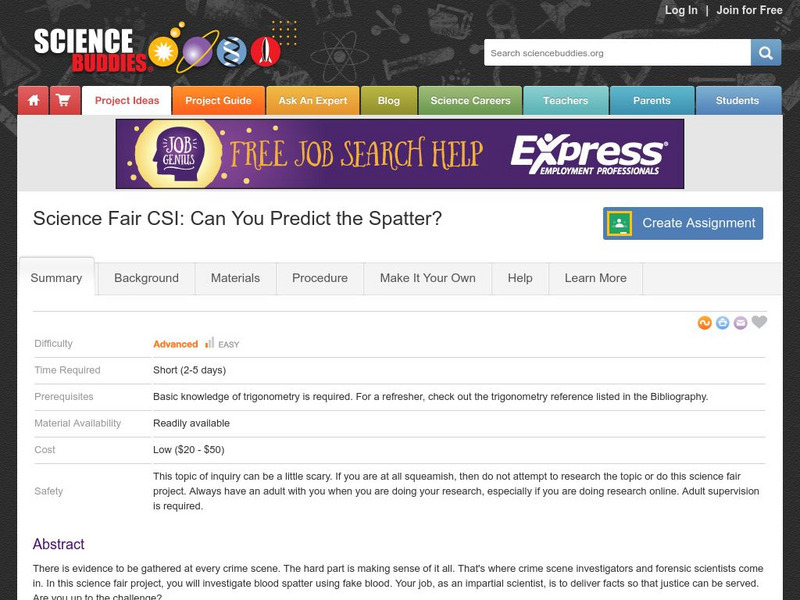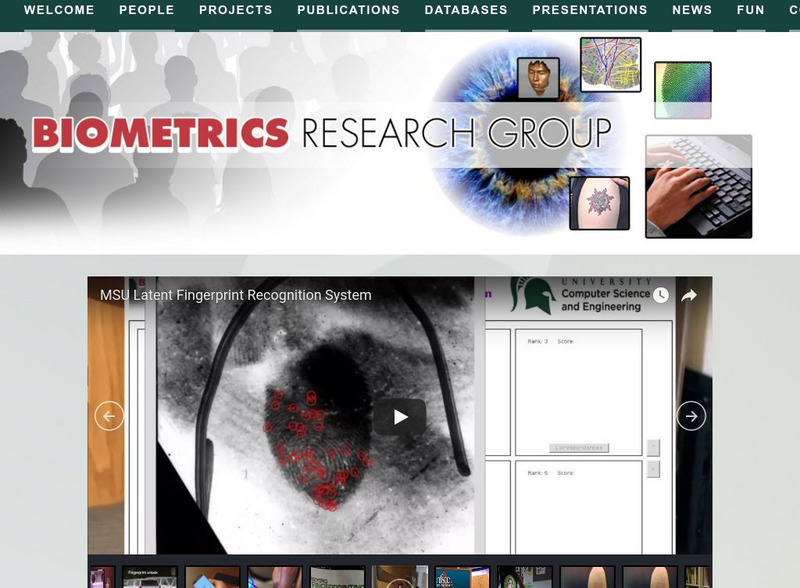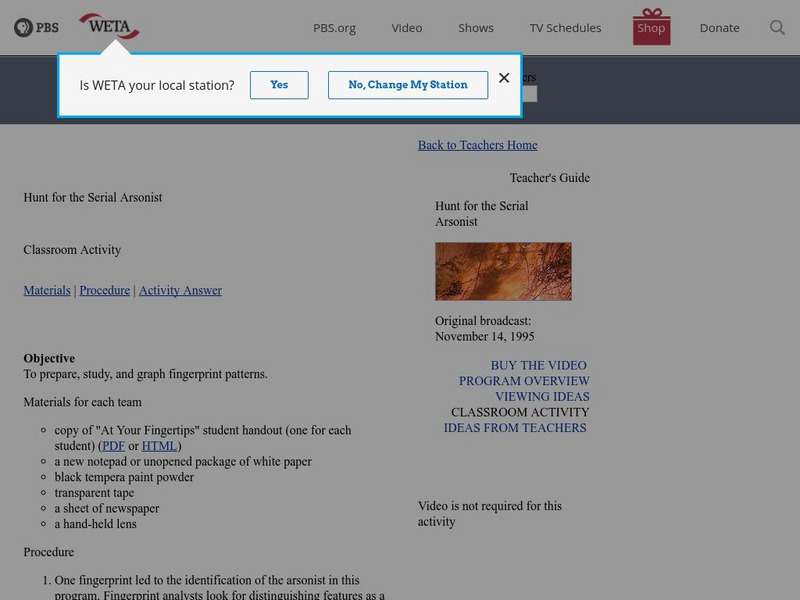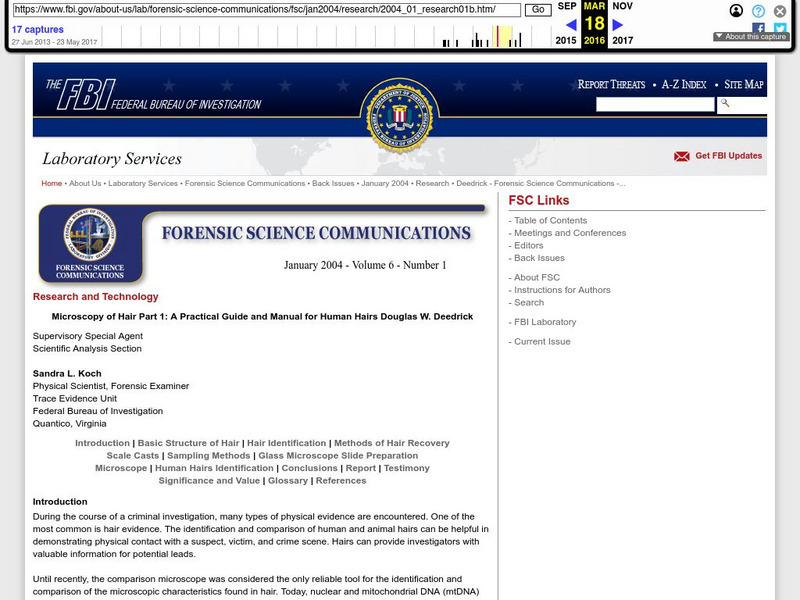Science Buddies
Science Buddies: Science Fair Csi: Can You Predict the Spatter?
There is evidence to be gathered at every crime scene. The hard part is making sense of it all. That's where crime scene investigators and forensic scientists come in. In this science fair project, you will investigate blood spatter...
PBS
Pbs: Scientific American Frontiers: Unearthing Secret America
The fun part of history is finding the clues that unlock the secrets of the past. This is the companion site to the TV show with Alan Alda that features archeological discoveries. Students will find interesting lessons from the past on...
TeachEngineering
Teach Engineering: Dna Forensics and Color Pigments
Students perform DNA forensics using food coloring to enhance their understanding of DNA fingerprinting, restriction enzymes, genotyping and DNA gel electrophoresis. They place small drops of different food coloring ("water-based paint")...
Michigan State University
Michigan State University: Biometrics Research
This is a site on the use of biometrics in personal identification. Includes a summary of some of the many types of biometric methods under development.
Nature Research
Scitable: Genetics and Society
Get an in-depth look at the ethical, legal, and social implications genetic technologies have on society. Explore the ethical considerations that genetics has on our society with the advances in genetically-tailored treatments, genetic...
PBS
Pbs Learning Media: Dna Fingerprint Photos
These photographs supplied by Genelex Corporation depict actual DNA fingerprints and show the types of information that can be gleaned from them.
Texas Instruments
Texas Instruments: Forensics Case 7 Drug Tests: Identifying an Unknown Chemical
In this activity, students distinguish between physical and chemical properties. They also understand the differences between qualitative and quantitative observations. They use quantitative and qualitative analyses to identify an...
Texas Instruments
Texas Instruments: Cells Never Lie
A forensics activity which deals with the idea of alcohol poisoning. Based on a Biology Lab on cell distruction in alcohol and Chemistry's Beer's Law.
Texas Instruments
Texas Instruments: Forensics Case 9: Killer Cup of Coffee: Using Colorimetry
In this activity, Students can use colorimetry to determine the concentration of a colored species in a solution and use a linear relationship to model Beer's law. They use Beer's law to determine the concentration of...
Natural History Museum
Natural History Museum: On Maggots and Murders: Forensic Entomology [Pdf]
Five-page article explains how forensic scientists, when investigating crimes, analyze maggots and blowflies to determine approximate times of death.
Virtual Museum of Canada
Virtual Museum of Canada: Virtual Exhibit on Forensic Science
Discover the components of forensic science. There is also a link to a simulation in which you can apply your skills to solve a crime.
PBS
Nova Teachers: Hunt for the Serial Arsonist: Classroom Activity
In this activity they can begin to see how forensic scientists use fingerprints for identification. Students will identify particularly noticeable features in fingerprints and compare students' fingerprints.
Other
Science Spot: Forensic Science Lesson Plans
Huge collection of teacher-created lessons, activities, PowerPoint presentations, and worksheets for classes in forensic science.
Federal Bureau of Investigation
Federal Bureau of Investigation: Practical Guide for Human Hairs
The FBI gives a detailed analysis of the human hair including how to use it as forensic evidence. Topics covered are hair structure, identification, and methods of hair recovery. Labeled diagrams and electron photomicrographs enhance the...
National Health Museum
Access Excellence: Dna Detectives
A hands-on activity from Access Excellence for advanced biology classes. Students are given a crime scenario and three suspects. Their mission is to determine 'Who Dunnit?' by obtaining and analyzing DNA samples. Requires extensive...
PBS
Pbs Teachers: Dead Men's Tales: Splatter Spread
Emulate the work of a forensic scientist by observing the relationship between scatter and distance. Assemble a projectile-hurling device called a potato cannon and analyze the spread pattern of paint soaked projectiles.
PBS
Pbs Teachers: Dead Men's Tales: Inferring Height From Bone Length
Explore the work of forensic scientists by inferring an individual's height from the length of certain long bones. Create bone/height relation charts and measure length using metric units. This activity was created to be used with the...
Other
Crime Scene Investigator: Evidence Collection Guidelines
A list of specific types of evidence that could be collected from a crime scene. Links to methods for collecting the following kinds of evidence: blood stains, seminal stains, hair, fibers and threads, glass, paint, flammable liquids,...
Other
Your Thoughts Is That Really You?
Biometrics has come to refer to the identification of individuals through distinguishing biological features. This article discusses what that might mean to us as individuals.
Other
American Academy of Forensic Science: Choosing a Career
What is forensic science? What do forensic scientists do? What's a forensic scientist? This complete site answers these questions and provides a wealth of information about the field of forensic science.
Oak Ridge National Laboratory
Oak Ridge National Laboratory: Dna Forensics
A concise explanation of the use of DNA technologies in forensic identification from the Oak Ridge National Laboratory. Additional valuable resources are provided.
Success Link
Success Link: Forensic Chemistry
An interesting lesson that taps into students' interest in crime solving and forensics. Students examine glass fragments and their density to help them solve a crime.
Khan Academy
Khan Academy: Meet Jared Roop
Meet Jared Roop, forensics/analytical chemist and Cardinals fan!
PBS
Pbs Teachers: Wanted Butch and Sundance: Classroom Activity
Examine how forensic anthropologists use data to investigate skeletal remains and use a data chart to estimate how tall a person might have been from the length of his or her bones.




















